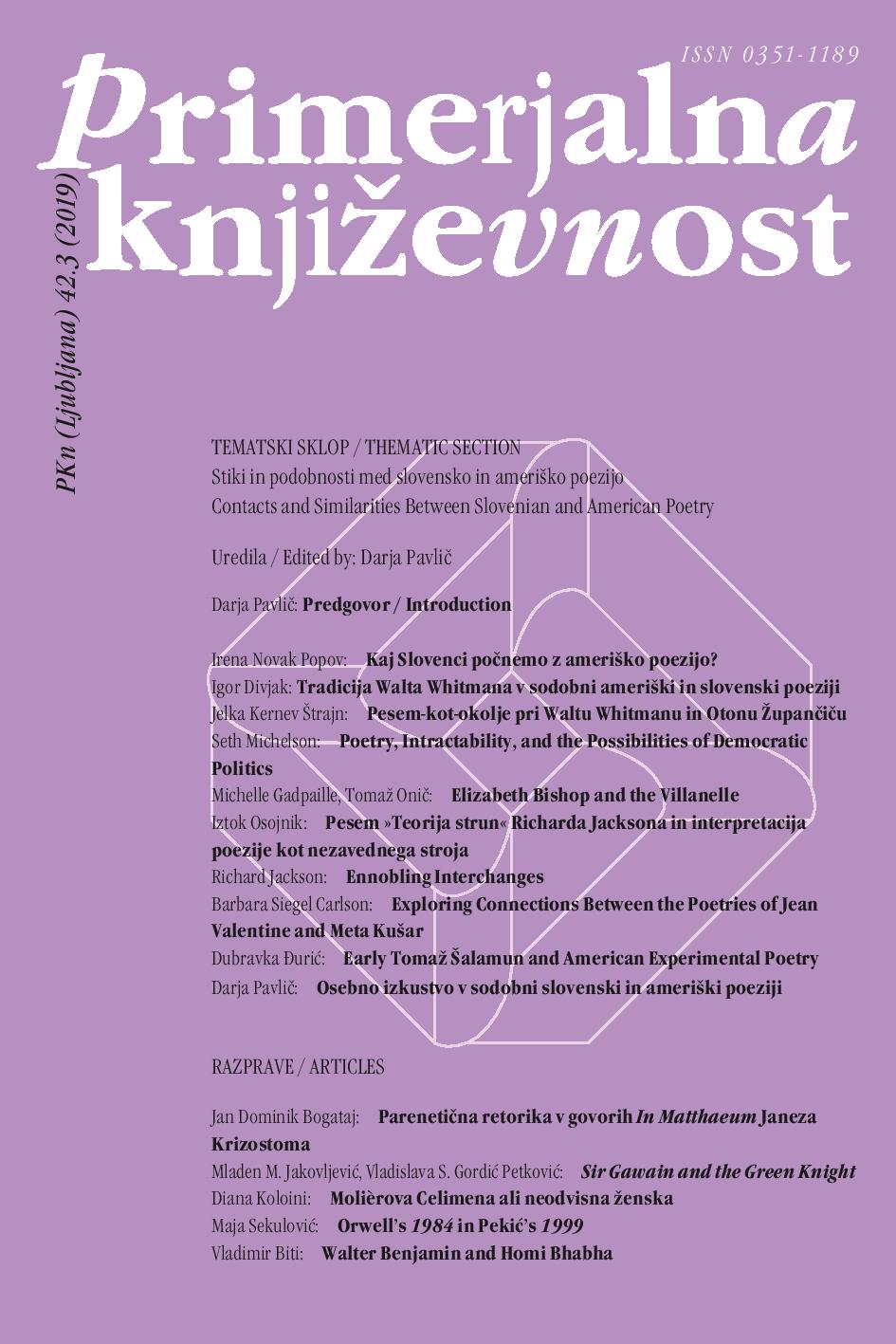Elizabeth Bishop and the Villanelle: One Art, an Ocean, and Two Languages
DOI:
https://doi.org/10.3986/pkn.v42.i3.05Keywords:
American poetry, Bishop, Elizabeth, villanelle, refrain, polysemic repetend, Slovenian translations, Taufer, VenoAbstract
The genesis of this study lies in Elizabeth Bishop’s famous poem, “One Art.” A villanelle, it stands out luminously against the background of contemporary poetics, the lingering legacy of modernist free verse and the many branches of experimental post-modernist poetry in the United States. It stands apart, with Theodore Roethke among the few precursors, claiming a traditional fixed poetic form—the 6-stanza villanelle—as a valid medium for expressing the late-twentieth-century concerns of a scholarly, peripatetic, lesbian poet. Formally, it is an anachronistic appropriation; aesthetically, it is a triumph. The questions triggered by Bishop’s poem and explored by this paper are three-fold: first, the adequacy of existing terminology for defining the refrain, where we propose the need for a new term: polysemic repetend. Our second question addresses the perceived global influence of “One Art.” We then turn to the presence of the villanelle in Slovenian poetics and consider how Bishop has been translated, since we assume that the formal complexity of the metrical and rhyme arrangement will present a challenge for the translator (Veno Taufer). The study thus works towards a modest appreciation of parallel New Formalist aesthetics between American and Slovenian poetry.References
Abrams, M. H., and Geoffrey G. Harpham. A Glossary of Literary Terms. Wadsworth: Cengage Learning, 2009.
Alkalay-Gut, Karen. “Overcoming Time and Despair: Ernest Dowson’s Villanelle.” Victorian Poetry 34.1 (1996). 101–107.
Baldick, Chris. The Oxford Dictionary of Literary Terms. Oxford: Oxford University Press, 2008.
Bennett, Bruce. “The Thing’s Impossible.” Ploughshares 37.2–3 (2011). 10–13.
Bishop, Elizabeth. The Complete Poems 1926–1979. New York: Farrar, Straus & Giroux, 1983.
– – –. Zemljevid. Ljubljana: LUD Šerpa, 2000.
Cerne, Helen. “Villanelle, a Writer’s Hell.” Hecate: A Women’s Interdisciplinary Journal 30.2 (2004). 124.
Deacon, Kelly. Rhyme, Rondeau and Villanelle. Peterborough, UK: Anchor Books, 2000.
Ellingsen, Eric. “The Long Poem of Walking.” World Literature Today 85.1 (2011). 41–45.
Ford, Karen Jackson. “Weaving Close Turns and Counter-Turns: The Villanelle.” A Companion to Poetic Genre. Ed. Erik Martiny. Chichester, Malden: Wiley-Blackwell, 2012. 172, 183–184.
French, Amanda L. “Edmund Gosse and the Stubborn Villanelle Blunder.” Victorian Poetry 48.2 (2010). 243–266.
– – –. Refrain Again: The Return of the Villanelle. PhD dissertation, University of Virginia. Charlottesville, 2004.
Gadpaille, Michelle. “Metaphor, Meme and MacLennan’s Two Solitudes.” Individual and Community: Canada in the 20th Century. 2nd International Conference of Central European Canadianists. Brno: Masaryk University, 2004. 19–25.
Geckle, George L. “Stephen Dedalus and W. B. Yeats: The Making of the Villanelle.” Modern Fiction Studies 15.1 (1969). 87–96.
Hirsch, Edward. The Essential Poet’s Glossary. New York: Houghton Mifflin Harcourt, 2017.
Hollander, John. “Breaking into Song: Some Notes on Refrain.” Lyric Poetry: Beyond New Criticism. Ed. Chaviva Hošek and Patricia Parker. Ithaca: Cornell University Press, 1985. 73–89.
Jarman, Mark. “Wedding Villanelle.” The Hudson Review 61.1 (2008). 42.
Jason, Philip K. “Modern Versions of the Villanelle.” College Literature 7.2 (1980). 136–145.
Kane, Julie. “The Myth of the Fixed-Form Villanelle.” Modern Language Quarterly 64.4 (2003). 427–443.
Lawrence, Anthony. “Explaining Villanelles to an Alien.” Poetry 213.6 (2019). 558.
Magnus, Laury. The Track of the Repetend: Syntactic and Lexical Repetition in Modern Poetry. PhD dissertation, City University of New York. New York, 1979.
Mead, Matthew. “The Unrhymed Villanelle.” Ambit 156 (1999). 49.
Millier, Brett Candlish. “Elusive Mastery: The Drafts of Elizabeth Bishop’s ‘One Art’.” New England Review 13.2 (1990). 121–129.
Muldoon, Paul. “Moving on Silence: Yeats and the Refrain as Symbol.” Yeats Annual 20 (2016). 155–177.
Northrop, Kate. “The Place Above the River.” American Poetry Review 39.4 (2010). 33.
Novak, Boris A. Mojster nespečnosti. Ljubljana: Mladinska knjiga, 1995.
– – –. Oblike duha. Ljubljana: Mladinska knjiga, 2016.
Novak Popov, Irena. “Contemporary Slovenian Poetry in Literary Studies.” Slavistična revija 61.1 (2013). 77–94.
Oak, Rachelle. “An Imperfect Villanelle.” Beside the Point: Camosun’s Literary Magazine 5 (2017). 30.
Parini, Jay. “The 10 Best American Poems.” Guardian Online 11 March 2011.
Pavlič, Darja. “Contextualizing Contemporary Slovenian Lyric Poetry Within Literary History.” Slovenian Studies 31.2 (2009). 161–170.
Ritchie, Elisavietta. “How to Write a Villanelle.” Poetry 179.5 (2002). 270.
Roethke, Theodore. Collected Poems of Theodore Roethke. New York: Doubleday, 1953.
Roos, Bonnie. “Refining the Artist into Existence: Pygmalion’s Statue, Stephen’s Villanelle and the Venus of Praxiteles.” Comparative Literature Studies 38.2 (2001). 95–117.
Schneiderman, Jason. “The Literary Anatomy—Teaching the Villanelle: The Satellite and the Snowball.” Teachers & Writers 34.2 (2002). 9–13.
Segal, Ian. “Our Poets on Their Poems: Edward Hirsch’s Rotating Refrain.” The New Yorker 10 March 2010.
Shapiro, David. “On a Villanelle by Elizabeth Bishop.” The Iowa Review 10.1 (1979). 77–81.
Spiegelman, Willard. “Heirs and Heirlooms: The Legacy of Elizabeth Bishop and James Merrill.” The Kenyon Review 13.2 (1991). 154–159.
Spivack, Kathleen. “Conceal/Reveal: Passion and Restraint in the Work of Elizabeth Bishop.” The Massachusetts Review 46.3 (2005). 496–510.
Taylor, Marilyn. “Repeat Yourself—with Purpose: The Art of a Villanelle Inspired by Dance Lies in the Graceful Repetition of Two Key Lines.” Writer (Kalmbach Publishing) 121.12 (2008). 15–16.
Vertreace, Martha Modena. “Sestinas and Villanelles from the Inner City.” Teaching English in the Two-Year College 24.1 (1997). 47.
Woodland, Michael. “‘Pursuit of Unsayables’: Repetition in Kristeva’s Black Sun and Strand’s ‘Two de Chiricos’.” Mosaic: An Interdisciplinary Critical Journal 37.3 (2004). 121–138.


